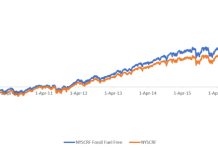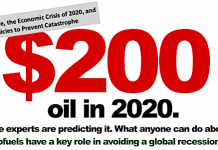Garvin Jabusch
![320px-Train_Crash_Cerhovice_1868_Chalupa[1].jpg](http://www.altenergystocks.com/wp-content/uploads/2017/08/320px_Train_Crash_Cerhovice_1868_Chalupa_1_.jpg)
A train, loaded with coal, crashed into the back of a passenger train in Czechloslovakia in 1868.
|
Securities of fossil fuels firms, as an economic sector, may soon be on the decline. Predictions as to when oil, gas and coal will become a smaller part of the investment society makes into its total energy mix in favor of renewables (such as solar, wind and ocean energies) vary, ranging from 2060 on the long side (this prediction from oil industry powerhouse Shell) to 2030 or even sooner on the shorter side (as reported by Bloomberg). But so far, markets appear to be mispricing the risk this presents to fossil fuels companies, and their share prices for now remain stable. In our opinion, it’s not too soon to consider divesting from fossil fuels while one might still recover significant value.
Coal, oil, and natural gas, though, are the main sources of energy that have gotten civilization this far (at least since the late 1700s, or the entire industrial revolution), so why are many expecting them to so quickly diminish in importance?
Mostly because of recent innovation and renewable energies’ efficiency and cost gains. Our ‘next economy’ thesis asserts that the energy and material resources we need to host an indefinitely thriving economy exist in more than sufficient quantities (particularly energy), if we would only collect and use them in smart and efficient ways. The innovations required to put world economies on a long term sustainable path largely exist today. For example, the various forms of solar energy collection have become so efficient over the last 20 years that all of civilization’s energy requirements could presently be met by covering 0.3% of the earth’s land surface with solar panels and concentrated solar thermal systems. Our models insist that through promoting true sustainability solutions in materials and energy, we can indeed maintain a healthy, thriving biosphere, all while growing our economies and improving standards of living potentially everywhere, for everyone.
This in mind, we put together 10 primary reasons why fossil fuels investments, in next economy terms and indeed in general economic terms, no longer appear to be the attractive source of risk-adjusted returns they have historically been.
Fossil fuels are economically becoming subprime because:
1. Fossil fuels have the capacity to threaten basic systems.
Warming and its sequelae such as severe weather, droughts, floods, more frequent and intense storms and attendant uncertainties all undermine our basic economic foundations. A recent World Bank report conceded that “There is … no certainty that adaptation to a 4° C world is possible,” referring to a global average temperature increase of 7.2 degrees Fahrenheit from pre-industrial times that is considered likely by scientists over the next few decades if fossil fuels’ use is not soon severely limited. To rephrase what this means, the traditionally conservative World Bank believes that human economies may not be able to adapt to a world that has on average warmed four degrees Celsius or more. Note that the global temperature has risen nearly one degree Fahrenheit since 1975.
Millions of pages have been written on the underlying reason for the unsustainability of fossil fuels. Their power to disrupt basic climate and therefore world societies is vast, complicated and is a topic best left to our best specialists. I suggest to the interested reader the works of more qualified practitioners including Dr. James Hansen, Lester Brown and Bill McKibben.
2. Fossil fuel assets present abandonment risk.
Fossil fuels companies are now confronted by the risk that many of the still-in-the-ground assets they count on their balance sheets and/or in their future revenue projections may never be recovered or realized. As this becomes the apparent, their asset valuations and revenue guidance may be revealed as currently far too high, and the values of their companies and stocks overvalued. Citing abandonment risk, Bloomberg recently reported that “Investors in carbon-intensive business could see $6 trillion wasted as policies limiting global warming stop them from exploiting their coal, oil and gas reserves.” Carbon Tracker reports that “Between 60-80% of coal, oil and gas reserves of publicly listed companies are ‘unburnable’ if the world is to have a chance of not exceeding global warming of 2°C.”
The press down under is reporting that “Australian based analysts at Citigroup say fossil fuel reserves in Australia face significant value destruction in a carbon constrained world, with the value of thermal coal reserves likely to be slashed dramatically if governments get serious about climate action…Fossil fuel asset owners could be best advised to dig the resource up as quickly as they can.”
Over at HSBC they recently pushed up a similar report, encompassing a global scale, essentially saying we can’t count all the fossil fuel reserves on firms’ balance sheets because we cannot burn them all and therefore “Oil and gas majors, including, BP, Shell and Statoil, could face a loss in market value of up to 60 percent should the international community stick to its agreed emission reduction targets.” (As reported by GreenBiz.com.) (I don’t believe most policymakers in governments around the world currently have the wherewithal to honor their various carbon reduction treaties, but I also don’t believe that matters. Peak oil demand is upon us because the alternatives are simply becoming far more competitive and because awareness of fossil fuels’ dangers is rapidly advancing.)
What Bloomberg, Citi and HSBC are saying, in sum, is that infinite growth of a known harmful asset – in this case an asset with the ability to disrupt climate and civilization – must come to an end, and soon. And shares of the firms exploiting this asset are at risk.
3. Renewables are becoming too competitive for fossil fuels.
Forbes has quoted Rick Needham, director of energy and sustainability at Google saying, “While fossil-based prices are on a cost curve that goes up, renewable prices are on this march downward.” That pretty much sums it up. In just the last five years, solar photovoltaic module prices have fallen 80 percent and wind turbines have become 29 percent less expensive. Moreover, after the initial investment, renewables such as wind and solar, having no cost of fuel, will prove far too competitive for fossil fuels no matter how cheap those may appear to be. Cheap fuel is still more than free fuel.
One of the first major investors to recognize this was Warren Buffett. Via his MidAmerican Energy subsidiary, he has quietly made Berkshire-Hathaway America’s single largest owner of both solar and wind electrical power generation capacity. Patrick Goodman, Buffett’s CFO of MidAmerican said simply “we believe renewables is the better investment right now.” Warren Buffet, who believes that once a good investment has been identified it’s time to “back up the truck,” is showing no signs of giving up his leader status on solar, having just begun construction on the “largest solar plant in the world.”
All this is happening now, today, with today’s technologies and today’s economics. That the smart money already sees renewable energies as more competitive long term than fossil fuels is obvious. The ‘smart money,’ by the way means individuals as well as institutions. Solar crowdfunding pioneer Mosaic in April of this year sold out the first tranche of $100 million in solar project investments to Californians in just hours.
Further technological advances aren’t required to make renewables competitive, but advances are occurring. Fossil fuels will represent only a small percentage of all energy investments in just a few years for a simple reason: few will want to invest in the less profitable technologies of the past.
4. Fossil fuels firms are beginning to have to pay for their externalities.
Fossil fuels companies have never had to pay for their economic externalities such as pollution, warming, health effects and contaminated water and farmland. There are signs that this is beginning to change, and firms will increasingly be liable for damages in the tens if not hundreds of billions. The highest profile example is BP’s Deepwater Horizon spill, the worst oil spill in U.S. history. BP has already been required to set up a US$20 billion fund to cover cleanup and damage costs, and perhaps far more significantly, is facing potentially “tens of billions” in additional damage payments pending the outcome of what the Financial Times is (in a dedicated section) calling the “trial of the century,” now underway in Louisiana. The FT is also reporting that BP is facing an additional 2,200 lawsuits related to the spill. Even if BP should prevail in most or even all of these suits, the massive costs of these litigations will start to become a drag on the firms’ traditionally easy profitability. Newsweek has a longform piece covering many details including additional BP liabilities such as: “that BP lied about the amount of oil it discharged into the gulf is already established. Lying to Congress about that was one of 14 felonies to which BP pleaded guilty last year in a legal settlement with the Justice Department that included a $4.5 billion fine, the largest fine ever levied against a corporation in the U.S.” BP’s continuing potential liabilities from this one incident, including “uncapped class-action settlements with private plaintiffs” and “civil charges brought by the Justice Department” and “a gross negligence finding [that] could nearly quadruple the civil damages owed by BP under the Clean Water Act to $21 billion,” show the danger to shareholders. Any representative of an asset class carrying this kind of risk can justifiably be labeled a subprime investment.
Other firms facing liability issues surrounding the dangerous nature of their products include Chevron, which has had to abandon Ecuador altogether to avoid paying a $US19 billion settlement there in a “nightmare case” that threatens to drag on around the world as Ecuador seeks payment via Chevron’s assets in other nations.
5. Fossil fuels are likely to have to face carbon taxes.
There will be carbon taxes in many if not most countries that will directly impact the profit margins of fossil fuels firms. The New York Times Op-Ed framed the argument like this:
“Substituting a carbon tax for some of our current taxes on payroll, on investment, on businesses and on workers is a no-brainer. Why tax good things when you can tax bad things, like emissions? The idea has support from economists across the political spectrum, from Arthur B. Laffer and N. Gregory Mankiw on the right to Peter Orszag and Joseph E. Stiglitz on the left. That’s because economists know that a carbon tax swap can reduce the economic drag created by our current tax system and increase long-run growth by nudging the economy away from consumption and borrowing and toward saving and investment.”
A carbon tax is good for everyone but fossil fuels companies, who will see their profits reduced (or attempt to pass the costs on to consumers, reducing demand for their products further). So far, several nations, provinces and individual municipalities have implemented a carbon tax, and many others have carbon trading schemes (the Carbon Tax Center is a good resource for keeping up with these). Carbon taxes can raise revenues, shrink deficits, and move tax burden away from citizens, all while slowing the worst effects of warming. Look for their implementations to continue to spread.
6. Fossil fuels will soon face diminishing governmental subsidies and benefits.
Fossil fuels have received as much as half a trillion dollars per year in subsidies from the U.S. alone. To the extent that austerity or desires to balance budgets, combined with legislation to limit greenhouse gas emissions, reduce the scale of this windfall, the seemingly easy profitability of these companies will be undermined. This point, as well as point five above, is more fully developed in point seven.
7. There is growing global institutional belief that transition to renewables solves climate AND economy.
We’ve already seen the dire warnings about warming coming from the World Bank, and discussed the positions of Bloomberg, Citi and HSBC. These institutions are far from alone. The International Monetary Fund, in calling for “Energy Subsidy Reform,” recently calculated that between directly lowered prices,
tax breaks, and the failure to properly price carbon, the world subsidized fossil fuel use by over $1.9 trillion in 2011 or eight percent of global government revenues, representing a huge drag on economies. The United States taxpayer is fossil fuels’ largest benefactor at $502 billion in 2011. China came in second at $279 billion, and Russia was third at $116 billion. For perspective, that $502 billion is just over 3% of the US economy, currently being given away to big fossil fuels companies.
The IMF concluded that the “link between subsidies, consumption of energy, and climate change has added a new dimension to the debate on energy subsidies.” The IMF’s solution to both economic and climate risk (as reported by The Hill) is in two simple parts: “end fossil fuel subsidies and tax carbon.” The solution to both climate and economy is worldwide conversion from fossil fuels to renewables.
8. Fossil fuels are the ultimate non-circular: they’re completely consumed upon first use, so more primary source extraction is required.
As I mentioned above, to get global economies on an indefinitely sustainable foundation, we need to make far more efficient use not only of energies but also of raw materials. Fossil fuels represent both raw resources and energy sources, and they represent the worst of both. Smart, efficient use of materials means reusing nearly everything at the end of its lifecycle to repurpose into something else we need. For a thriving, sustainable long-term economy, we need to get close to perfect recycling of resources of all kinds so we can minimize our depletist impacts on earth and avoid the basic environmental degradations that go along with those.
This approach of course excludes fossil fuels and other resources that are consumed entirely on their first use. Raw materials can keep economies growing for a long time if we preferentially mine our huge stockpiles of already extracted resources and minimize extraction from primary, geological sources. But fossil fuels, unlike materials used to make solar panels and wind turbines, don’t work like that. Since they are consumed entirely on their first use, reuse is impossible and we have to literally go back to the well for more. This means ever more greenhouse gasses in the atmosphere, ever more degrading of the local environments where extraction takes place, ever more risk of accidents, and the possibility of eventually exhausting the resource completely (although on this last point I personally believe we will – for the reasons presented here – reach peak demand far before we fully exhaust fossil fuel reserves).
9. Distributed renewable energy grid is more secure than traditional hub and spoke systems, even those powered by domestic fossil fuels.
FERC Chairman Jon Wellinghoff has recently said, “It wouldn’t take that much to take the bulk of the power system down. If you took down the transformers and the substations so they’re out permanently, we could be out for a long, long time,” and “A more distributed system is much more resilient…Millions of distributed generators can’t be taken down at once.”
This is common sense. And short of equipping every home and business with its own diesel or natural gas generator – which of course would be disastrous for local areas’ air quality – fossil fuels can never offer anything like the kind of security and resilience that distributed renewables like rooftop solar can.
10. Renewables will counter fossil fuels’ endless ‘boom and bust’ economic cycles.
As I’ve posted before, the price of oil and other fossil fuels has, at least since World War II, been the main control knob permitting expansion and causing contraction of world economies. It’s widely known that 10 of the last 11 major recessions were preceded by peaks in oil prices. Rising oil prices are inflationary, adding to the costs of almost everything from transportation to fertilizers to plastics, and they therefore cause demand for all these affected items to become depressed, slowing economic production. Renewables, relying as they do on free fuels like sunlight, present no such economic pressures, and as they become an ever larger percentage of our energy mix, fossil fuels’ huge GDP drag will begin to disappear.
Conclusion
What then is the future for fossil fuels versus renewables? Fossil fuels have already begun to rapidly lose market share. In 2012, most new electricity generating capacity brought online in the United States was from renewables, and in January and now March 2013, all new U.S. electrical generating capacity was provided by renewables. So where is this headed?
Image courtesy BNEF
Bloomberg New energy Finance (BNEF) has calculated that “70% of new power generation capacity added between 2012 and 2030 will be from renewable technologies (including large hydro). Only 25% will be in the form of coal, gas or oil.” BNEF CEO Michael Liebreich has said “I believe we’re in a phase of change where renewables are going to take the sting out of growth in energy demand,” which goes to our thesis that we can both lighten our ecological footprint and increase our standards of living.
So add Bloomberg to the growing group of financial analysts warning that fossil fuel investments are poised to become a bad bet.
Citi bank, in its note about the Australian coal industry, went as far as to warn investors that it will be difficult to extract value from their still-in-the-ground resources as action on climate change advances, stating, “If the unburnable carbon scenario does occur, it is difficult to see how the value of fossil fuel reserves can be maintained, so we see few options for risk mitigation.” (Italics added; Source.)
Well, with all due respect to Citi, I can think of one option: we, like Buffett and Google, can instead invest in civilization’s non-carbon sources of power. As the IMF pointed out, the solution to both climate and economy is worldwide conversion from fossil fuels to renewables. This massive conversion program will lead to powerful economic growth, less economic drag from energy costs, higher reve
nue for treasuries, and strong employment drivers.
If we fear for the future, it is paradoxical to attempt to mitigate risks by remaining invested in fossil fuels. What we do now will bring about the future for better or worse. If we’re to emerge from our 19th century energy system, it must be us, now, today, who set that emergence in motion. Leave fossil fuels for those who prefer to look backwards.
Garvin Jabusch is cofounder and chief investment officer of Green Alpha ® Advisors, LLC. He is co-manager of the Shelton Green Alpha Fund (NEXTX), of the Green Alpha ® Next Economy Index, and of the Sierra Club Green Alpha Portfolio. He also authors the Sierra Club’s green economics blog, “Green Alpha’s Next Economy.”






